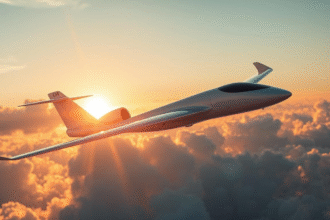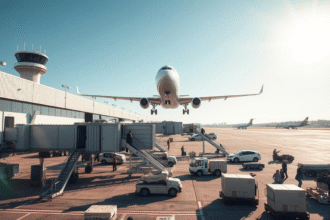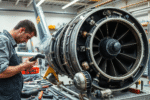In the aviation world, I know how vital aircraft engine repair is. It ensures aviation excellence and keeps flights safe.
I provide full repair solutions to get engines running at their best. My skills in maintenance and repair help me offer top-notch solutions. These solutions meet the highest quality and reliability standards.
aircraft engine repair
Key Takeaways
- Comprehensive solutions for aircraft engine parts complete repair
- Expertise in engine maintenance and repair for aviation excellence
- High-quality and reliable repair services
- Focus on restoring optimal engine performance
- Commitment to meeting the highest standards of quality and reliability
The Critical Role of Aircraft Engine Maintenance
Aircraft engine maintenance is key to aviation safety and efficiency. As an aviation pro, I know keeping engines in great shape is vital. It’s not just about following rules; it’s about keeping everyone safe.
aircraft engine maintenance
Good engine maintenance boosts flight safety. A well-kept engine is less likely to fail, cutting down accident risks. Regular checks also catch problems early, making flying safer.
How Engine Performance Impacts Flight Safety
Engine performance is a big deal for flight safety. If an engine isn’t running well, it can use more fuel and even fail. I stress the need for regular checks to avoid these issues.
The Relationship Between Maintenance and Operational Costs
Engine maintenance and operational costs are closely linked. While it might seem like extra spending, it actually saves money. It improves fuel use, cuts down on expensive fixes, and shortens downtime.
Building a Proactive Maintenance Culture
Creating a proactive maintenance culture means thinking ahead. It’s about regular checks, using new tech for predictive maintenance, and training staff to spot and fix issues early.
By focusing on engine maintenance, airlines can improve flight safety and lower costs. It’s not just about following rules; it makes flying safer and more reliable.
Common Aircraft Engine Types and Their Unique Repair Needs
Aircraft engines come in three main types: piston, turboprop, and jet. Each has its own repair needs. Knowing these differences is key for good maintenance and repair.
Piston Engine Repair Considerations
Piston engines are found in smaller planes. They need careful maintenance because of their complex design. Important tasks include checking cylinders, replacing piston rings, and keeping the crankshaft in good shape.
Regular checks can help lower repair costs. This is because problems are caught early, before they get worse.
Turboprop Engine Maintenance Challenges
Turboprop engines are efficient in some planes. But, they have special needs. These include checking turbine blades and the gearbox carefully. They need a deep understanding of their systems.
Jet Engine Specialized Repair Requirements
Jet engines are fast and complex. They need special repair methods. Key areas include:
- Compressor section repairs
- Combustion chamber maintenance
- Turbine component servicing
Compressor Section Repairs
The compressor section is key for jet engine performance. Repairs often involve replacing blades and inspecting the casing.
Combustion Chamber Maintenance
Keeping the combustion chamber in good shape is important. It involves checking fuel nozzles and liners.
Turbine Component Servicing
Turbine parts face extreme heat. They need regular checks and service to avoid failure.
jet engine repair
| Engine Type | Key Repair Areas | Special Considerations |
| Piston Engine | Cylinder inspection, piston rings | Complex design, regular checks |
| Turboprop Engine | Turbine blades, gearbox | Precise inspection, complex systems |
| Jet Engine | Compressor section, combustion chamber, turbine components | High-speed components, complex aerodynamics |
Each engine type has its own repair needs. Understanding these is essential for effective engine overhaul and maintenance.
Recognizing When Your Aircraft Engine Needs Professional Repair
Knowing when your aircraft engine needs repair is key to keeping it safe and running well. As engines get more complex, the signs of trouble can be hard to spot. So, it’s important to keep a close eye on things.
Performance Indicators of Engine Problems
How well your engine performs is a big clue to its health. If it’s not running as strong as it should, or if it’s using more fuel than usual, there might be a problem. You might also hear strange noises.
Visual Inspection Red Flags
Checking your engine with your eyes can help catch issues early. Look for leaks, damaged parts, or parts that are wearing out too fast. These signs mean your engine might need a pro to look at it.
Analyzing Engine Data for Early Problem Detection
Today’s aircraft engines have advanced systems that track how they’re doing. By looking at this data, you can spot problems before they get worse. Pay attention to:
- Temperature anomalies
- Pressure fluctuations
- Unusual vibration patterns
Temperature Anomalies
When your engine’s temperature is off, it’s a warning sign. If it’s too hot or the temperature changes a lot, it could mean something’s wrong with the cooling system or the engine itself.
Pressure Fluctuations
Changes in engine pressure can mean there’s a leak or blockage. Keeping an eye on oil pressure and other important systems is important for catching problems early.
Unusual Vibration Patterns
Strange vibrations in your engine can mean it’s not balanced right. These vibrations can cause damage and even lead to serious failures if not fixed.
| Indicator | Description | Potential Cause |
| Temperature Anomalies | Overheating or unusual temperature fluctuations | Cooling system malfunction, internal engine wear |
| Pressure Fluctuations | Changes in oil pressure or other critical systems | Leaks, blockages |
| Unusual Vibration Patterns | Imbalance or misalignment within the engine | Premature wear, potentially catastrophic failure |
My Complete Aircraft Engine Repair Process
My aircraft engine repair process aims to get engines running smoothly again. It includes detailed diagnostics, precise repairs, and strict quality checks.
Initial Assessment and Diagnostic Procedures
The first step is a detailed initial assessment. I use diagnostic procedures to find any engine problems. Advanced tools help me analyze the engine’s performance and find issues.
I run tests to check the engine’s condition. This includes looking at performance data, checking for wear or damage, and running diagnostic tests.
Component-Specific Repair Methodologies
After diagnosing, I create a repair plan for the engine. This plan focuses on component-specific repair methodologies for each part.
I repair or replace parts to get them working perfectly. I mix traditional methods with modern technology for the best results.
Complete Engine Overhaul Services
Sometimes, a full engine overhaul is needed. This means taking the engine apart, inspecting, repairing, and putting it back together.
Disassembly and Inspection Protocols
When disassembling, I follow strict protocols. I inspect each part carefully for wear or damage. This helps me catch any issues early.
Precision Repair and Replacement Techniques
With the engine apart, I use precision repair and replacement techniques to fix or replace damaged parts. This ensures the engine runs at its best.
Reassembly and Quality Control Measures
After repairs, I reassemble the engine carefully. The final step is quality control measures to ensure the engine meets high standards of performance and safety.
This detailed process ensures the aircraft engine is fixed to the highest standards. It guarantees reliability and safety for flights.
Specialized Tools and Technologies in Aircraft Engine Repair
Fixing aircraft engines needs advanced tools and tech. As an expert, I use top-notch equipment. This ensures engines work well and are safe to fly.
Advanced Diagnostic Equipment
Special diagnostic tools are key for finding engine problems. Engine and vibration analyzers help me find issues fast. This cuts down on downtime and makes repairs more efficient.
Precision Machining Capabilities
Precision machining is vital for making and fixing engine parts. My workshop has the latest CNC machines. These machines make parts with high precision, meeting or beating original specs.
Non-Destructive Testing Methods
NDT methods are essential for checking engine parts without damage. I use ultrasonic inspection, magnetic particle testing, and borescope inspection to spot defects or weaknesses.
Ultrasonic Inspection Techniques
Ultrasonic inspection uses sound waves to find internal flaws. It’s great for checking parts that are hard to see or reach.
Magnetic Particle Testing
Magnetic particle testing finds defects in magnetic materials. By applying a magnetic field and particles, I can see hidden defects.
Borescope Inspection Procedures
Borescope inspection lets me see inside engine parts with a flexible or rigid borescope. It’s perfect for checking hard-to-reach areas like combustion chambers and turbine blades.
The table below shows the main NDT methods used in aircraft engine repair:
| NDT Method | Description | Application |
| Ultrasonic Inspection | Uses high-frequency sound waves to detect internal flaws | Inspecting engine components for internal defects |
| Magnetic Particle Testing | Detects surface and subsurface defects in ferromagnetic materials | Inspecting engine parts made of ferromagnetic materials |
| Borescope Inspection | Visual inspection of internal engine components using a borescope | Examining hard-to-reach areas such as combustion chambers |
Using these specialized tools and technologies, I ensure aircraft engines are fixed to the highest standards. This keeps them safe and performing well.
Regulatory Compliance and Certification in Aircraft Engine Repair
Aircraft engine repair must meet strict safety standards. This ensures that engines are fixed correctly, keeping both the plane and its passengers safe.
FAA Requirements and Repair Station Certifications
The Federal Aviation Administration (FAA) has strict rules for engine repair shops. Shops need FAA certification to legally repair engines. They must show they have the right equipment, trained staff, and quality control.
Key aspects of FAA certification include:
- Compliance with 14 CFR Part 145 regulations
- Adequate training and qualification of personnel
- Implementation of a robust quality control system
Documentation and Record-Keeping Standards
Keeping accurate records is key in engine repair. Shops must document all work done, including parts used and inspections. This helps ensure the engine is safe and makes future maintenance easier.
Maintaining Repair Records
Repair records should detail the work done, like the engine type and serial number. These records must be kept safe and accessible for inspections.
Parts Traceability Requirements
It’s important to track parts used in repairs. Shops must document where parts come from, whether new, used, or overhauled. This includes part numbers and supplier info.
Return-to-Service Documentation
After repairs, shops must provide a return-to-service document. This confirms the engine is safe to fly.
Airworthiness Directives and Service Bulletins
Shops must follow FAA and engine maker directives. These include mandatory inspections and repairs to keep the engine safe.
By following these rules and keeping detailed records, repair facilities help keep aviation safe.
Cost Factors in Professional Aircraft Engine Repair
Understanding the costs of fixing an aircraft engine is key for operators. Knowing what affects these costs helps in making smart choices about engine care and fixes.
Breaking Down Repair Expenses
Repair costs for aircraft engines fall into a few main areas. These include parts, labor, and any extra services needed to get the engine running again.
Comparing Repair vs. Replacement Economics
When an engine needs big repairs, operators must choose between fixing it or replacing it. This choice depends on the cost of each option and how reliable and efficient the engine will be in the future.
Insurance and Warranty Considerations
Insurance and warranties can greatly affect repair costs. It’s important to understand these to manage expenses well.
Parts Procurement Strategies
Getting parts efficiently is key to saving on repair costs. Options include buying from the original makers, using aftermarket parts, or fixing existing parts.
Labor Cost Variables
Labor costs depend on the repair’s complexity, the techs’ skills, and the facilities. Knowing these can help control labor costs.
Downtime Management
Keeping downtime low is essential to save on repair costs. Ways to do this include fixing things during slow times and having spare parts ready.
| Cost Factor | Description | Impact on Total Cost |
| Parts Procurement | Sourcing of necessary components | High |
| Labor Costs | Technician expertise and time | Moderate to High |
| Downtime Management | Strategies to minimize operational loss | Moderate |
Preventative Maintenance Strategies to Extend Engine Life
To make your engine last longer, you need a good maintenance plan. This plan helps your engine run better and lowers the chance of sudden breakdowns.
Scheduled Maintenance Recommendations
Regular maintenance is key to a long engine life. It includes checks, part swaps, and big overhauls as the maker suggests. Following these schedules helps spot problems early.
Pilot Best Practices for Engine Care
Pilots are very important for engine upkeep. They should use gentle throttle, stay away from extreme heat, and watch engine stats closely. This keeps the engine in good shape.
Oil Analysis and Condition Monitoring Programs
Oil checks and condition monitoring are big parts of maintenance. They help find engine wear or contamination early. Condition monitoring systems give live data on how the engine is doing.
Proper Engine Operation Techniques
Running the engine right and avoiding harsh conditions helps it last longer. This means not idling too long, not using too much power, and warming up and cooling down right.
Storage and Inactivity Considerations
When an aircraft is stored or sits idle for a while, you need to take extra steps. Use special coatings, seal off intake and exhaust, and run the engine now and then to stop rust.
Environmental Protection Measures
Keeping the engine safe from dust, moisture, and extreme weather is important. Use covers, filters, and keep the area clean to protect it.
Using these maintenance strategies can make your aircraft’s engine last longer. It also makes flying safer and can save money.
Conclusion: Partnering for Safe and Reliable Aircraft Operation
Keeping aircraft engines safe and reliable needs a full plan for maintenance and repair. Working with skilled experts helps aircraft owners get top-notch solutions. These solutions focus on making flying safe and efficient.
We’ve looked at key parts of aircraft engine care in this article. This includes spotting engine issues early and following safety rules. Doing regular maintenance and using the latest repair methods is key to keeping engines running well.
By focusing on engine performance and safety, we can make flying much safer. I suggest that aircraft owners make these areas their top priority. This way, they can keep their fleets running smoothly and safely.
FAQ
What is the typical turnaround time for aircraft engine repair?
The time it takes to repair an aircraft engine varies. It depends on the engine type, damage extent, and parts availability. On average, repairs can take from a few weeks to a few months.
How do I know if my aircraft engine needs a complete overhaul?
Your engine might need an overhaul if it’s past its recommended maintenance time. Or if it has suffered significant damage. I can do a detailed inspection to figure out the best option.
What is the difference between a repair and an overhaul?
Repairing an engine fixes a specific problem. An overhaul, on the other hand, involves a full disassembly, inspection, and rebuild. It aims to restore the engine to its original state.
Can you repair any type of aircraft engine?
I’ve worked on many aircraft engines, including piston, turboprop, and jet engines. But, it’s best to check if I can work on your specific engine before starting.
How do you ensure compliance with FAA regulations and guidelines?
I follow FAA rules closely. This includes having the right certifications, keeping proper records, and following documentation standards. It ensures all repairs meet FAA standards.
What kind of warranty do you offer on your repairs?
I provide a warranty on my repairs. It covers parts and labor for a certain time. The warranty specifics depend on the repair type and engine.
Can I get a quote for the repair before committing to it?
Yes, I give detailed quotes for repairs. These quotes outline costs for parts, labor, and any extra services needed.
How do you handle parts procurement for the repair?
I work with trusted suppliers for parts. This ensures timely and affordable part acquisition. I also check parts quality to meet or exceed OEM standards.
What kind of reporting and documentation can I expect during the repair process?
I keep detailed records of the repair. This includes inspection reports, repair documents, and test results. I also keep you updated on the repair’s progress and let you know when it’s done.
Can you perform on-site repairs or inspections?
Sometimes, I can do on-site repairs or inspections. It depends on your specific needs and location. Let’s discuss your situation to see what’s best.
Engine Component Repair: We fix worn-out or damaged engine components with precision.
Jet Engine Overhaul: Ensure your jet engines run smoothly with our comprehensive overhaul services.
Aircraft Parts Replacement: We source and replace engine parts with certified and high-quality components.
Regular Engine Inspections: Preventive maintenance to avoid unexpected failures.







